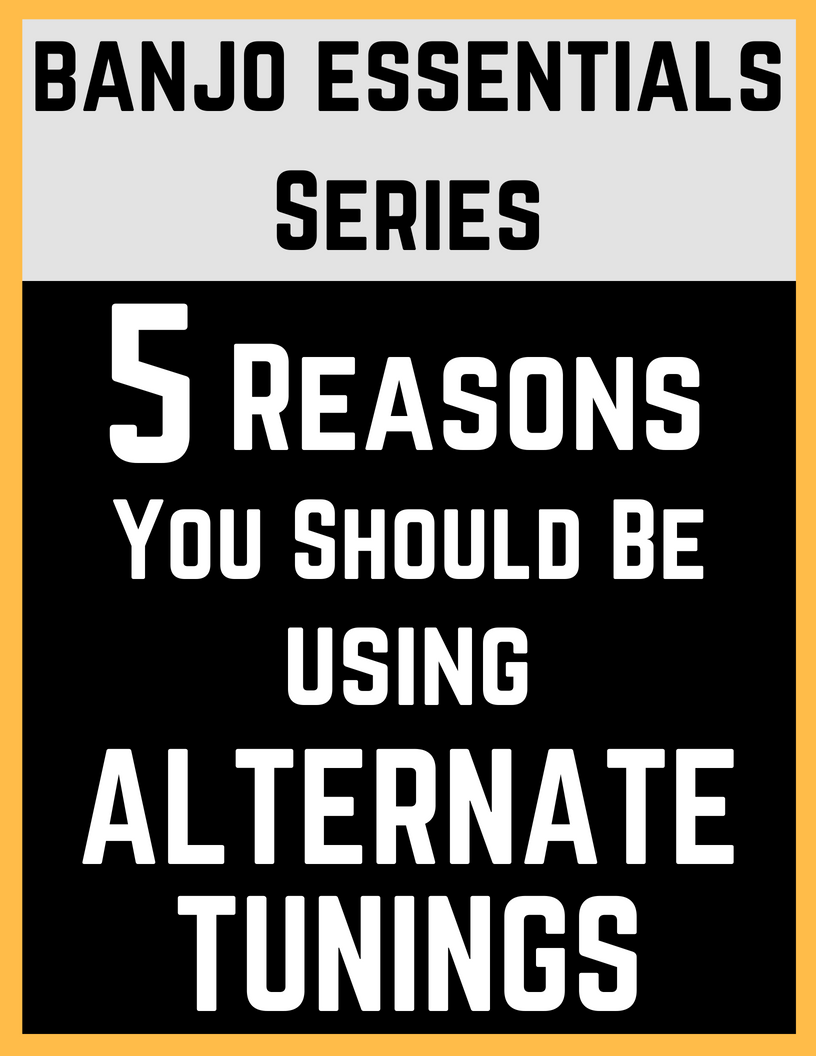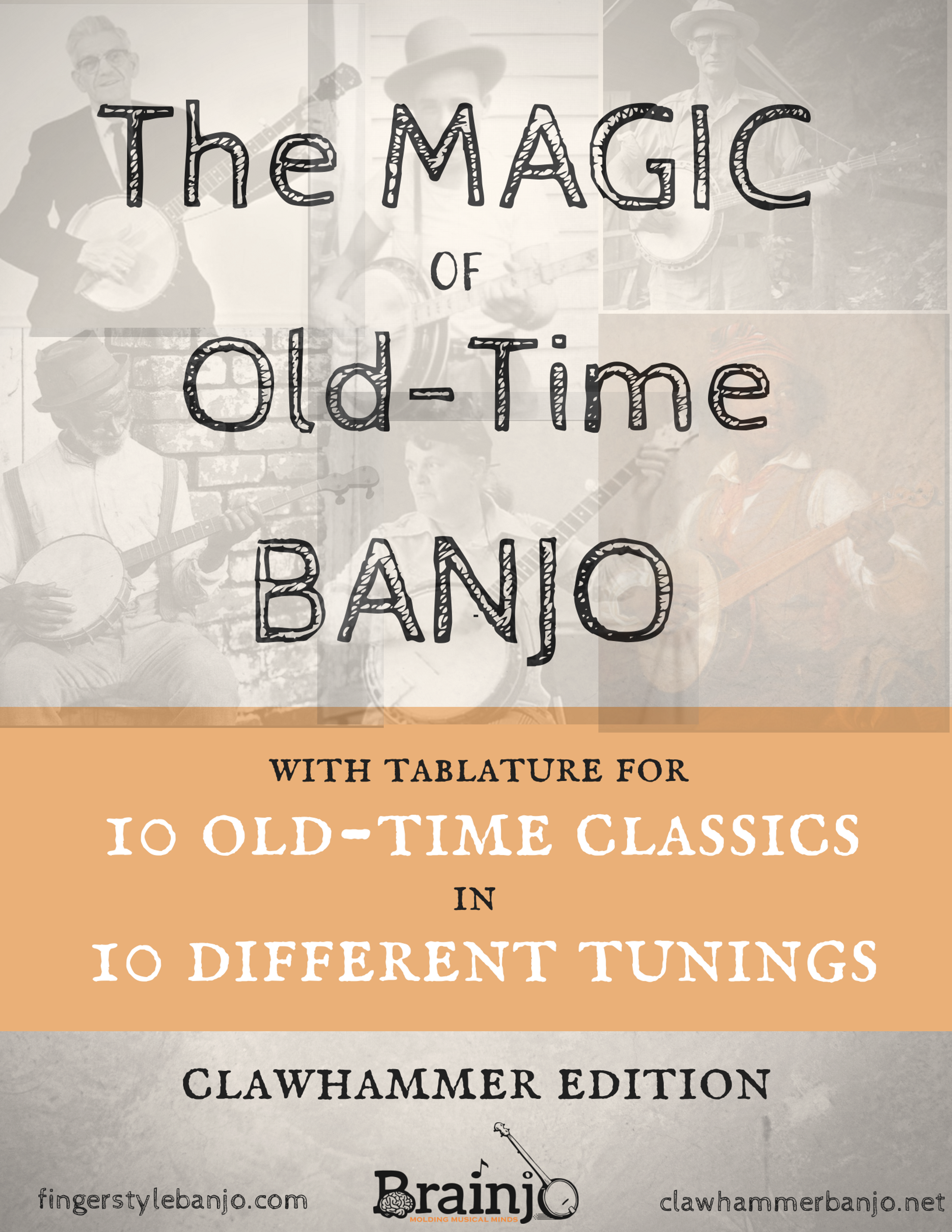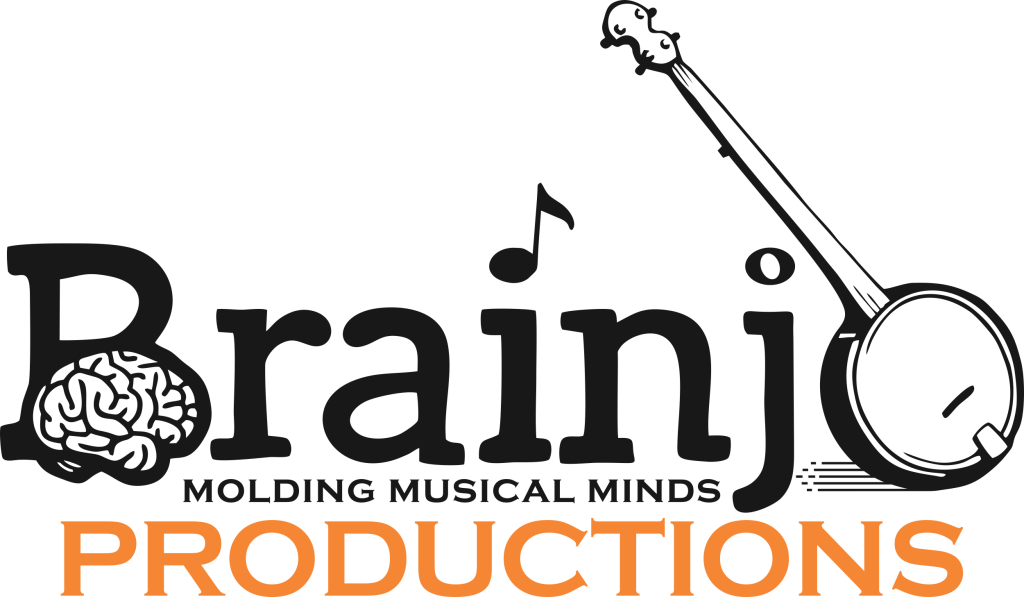
In this article, you’ll learn why alternate tunings are used, why you should strongly consider using them if you’re a banjo player, why they shouldn’t be feared, and then how to approach using them according to what your goals are on the banjo.
One of the most common questions that arises from beginning banjo players is: do I REALLY need to learn alternate tunings?
Or to put it another way, why can’t I just learn all of my songs out of the same tuning?
And I get it. In fact, many years ago, I said those same exact things.
An Alternate to What, Exactly?
First of all, I should point out that the term that we use to describe the various tunings – “alternate” – implies that there’s some standard that you’re deviating from. The word alternate suggests that there’s a norm that’s being deviated from.
This alone may be part of the problem, as the truth is there really is no such thing as a standard tuning.
Sure, there are some tunings that may be preferred in certain styles or genres (standard G for bluegrass, for example, since that’s the one Earl Scruggs liked), but there isn’t any one tuning that’s inherently better for banjo playing than another.
As with most things, and “rules” we concoct exist only in our shared imaginations.
There’s a range of notes each string can accommodate, creating an exceedingly large number of possible combinations. Which means you can tune your banjo strings to anything you want, and whatever tuning you end up with is no less “right” than anyone else’s tunings.
That being said, in this day and age, most people who would ask the above question would probably consider standard G, or gDGBD, as the default tuning, as more often than not this is the one most banjo instruction begins with (an artifact of history, rather than an inherent property of the banjo).
It’s also worth noting that the resistance to alternate tunings most commonly comes from people with some prior experience playing the guitar, which is completely understandable. The guitar’s rise in popularity coincided with the rise in chord-driven music. As such, the typical approach to learning the guitar is to start by learning the chords.
And learning chords for the first time – both where they’re located and how to get your fingers into all those awkward positions, is a major pain in the rear.
And people tend to want to avoid things that are major pains in the rear! Being able to play the primary chords on the guitar is a major learning milestone, and a process few people want to repeat!
As mentioned, the main reason most guitar players only play out of one tuning is because the guitar, and the music most commonly played on it, is chord driven. And the primary advantage of playing out of one tuning is only having to learn one set of tuning-specific chord formations. For most, this is enough to overcome the drawbacks to not playing in multiple tunings.
But here’s one really important thing to remember: a banjo is not a guitar.
And while there are similarities in how you approach the playing of the banjo and the guitar, there are also some really fundamental differences, which we’ll explore in a sec.
Like I said, I can easily relate to this resistance.
I played the guitar before I played the banjo. I resisted alternate tunings on the banjo, and I kept my banjo in standard G for over a year before ever venturing to anything else.
So what convinced me that I was wrong? Actually tuning to another tuning!
As soon as I played my first tune in double C – scratch that – as soon as I played my first few notes on double C, I was sold.
The truth is, there’s no better way to persuade yourself to play in different tunings than to just re-tune your banjo and try them out.
But before you do so, let’s now review 5 great reasons for why you should be using alternate tunings, followed by how to go about using them, as I think this discussion will deepen your understanding of why the banjo is such a magical instrument, and allow you to better understand how to unlock that magic.
BREAKTHROUGH BANJO Bonus: “The Magic of Old Time Banjo”
10 glorious old time banjo tunes in 10 different tunings
 Some of the most classic banjo tunes of all time are played out of alternate tunings. There’s no better way to appreciate the wonders of the alternate tunings than to experience them for yourself.
Some of the most classic banjo tunes of all time are played out of alternate tunings. There’s no better way to appreciate the wonders of the alternate tunings than to experience them for yourself.
These tunes, many of which were originally written for solo banjo, showcase the banjo like none other.
I’ve recently created The Magic of Old Time Banjo book of tabs, which includes 10 of the most iconic tunes in alternate tunings. Each tune includes two arrangements, one that’s replicates the original iconic version (usually Brainjo level 3), and a slightly simplified, but equally awesome Brainjo level 2 version.
The book is now part of the “Magic of Old Time Banjo” module in the Breakthrough Banjo course, which will also includes slowed down tune tutorials of each of these arrangements.
Click here to learn more about Breakthrough Banjo and to sign up.
The 5 Incontrovertible, Undeniable Reasons To Use Alternate Tunings!
REASON #1: The Fifth String
As you are probably well aware, the banjo is a drone instrument. A critical distinction when compared with the guitar, and a central reason why multiple tunings exist.
Because with a drone instrument, we have one pitch, one note, which does not change when we play. It’s purpose is to sit there gloriously droning on in the background throughout the music we’re making.
And unless we’re going for ear piercing dissonance, that drone note needs to complement, or sound good against, the rest of what we’re playing.
A good sounding drone, at a minimum, needs to be a note in the scale of the key we’re playing in, and ideally (with some exceptions) either the 1st (the “tonic”) or the 5th (the “dominant”) note.
So even if we do want to play everything out of a single tuning, we still must account for the 5th string drone, either by re-tuning it when possible to fit with the key, or by avoiding it altogether. Of course, if we avoid it altogether, we lose the whole point of playing a drone instrument to begin with and might as well pick up one of those 4-string monstrosities (just a joke all you tenor and plectrum fans!).
In fact, just looking at the way the banjo is designed, with a fifth string drone that isn’t fretted, it’d be logical to expect to have to retune for every key. Trying to play everything out of one tuning will always require some kind of compromise.
REASON #2: They Sound Better
The banjo, especially modern banjos with well fit components, metal parts, and steel strings, is a highly resonant instrument.
That means that when you pick a note, those string vibrations are transmitted throughout the instrument. And every vibrating part of the banjo then contributes to the sound you hear.
Part of that sound is the other strings, the ones you didn’t pick, but are set in motion nonetheless. And so since those strings will contribute to the sound you hear, how those strings are tuned matters. It matters even when those strings aren’t being picked directly.
The “modal” tunes and tunings are a great illustration of this – the notes may stay the same whether you play a song out of standard G or G modal, but the mood of it changes entirely. All because of those other strings ringing sympathetically.
So the tuning itself becomes part of the music, and clearly banjo players throughout history have recognized this feature.
To me, this extra sonic atmosphere is one of the great joys of playing the banjo, adding a layer or dimension of sound to the music that’s not present with other instruments like the guitar.
As an example, check out these two renditions of the tune “Miss McLeod’s Reel.” One is played out of standard G tuning (gDGBD), and one out of fDGCD tuning. It’s the same tune, but each tuning imparts an entirely different character to the resulting sound.
The Clawhammer Tune and Tab of the Week
Both of these were part of the Clawhammer Tune and Tab of the Week Series, and tabs are available for each.
— Click here for the tab for Miss McLeod’s Reel and sign up for the Tune of the Week —
REASON #3: More Open Strings To Play
For the most part, key specific tunings allow us to play more open strings when playing a song designed for that tuning.
Why is this a good thing?
One, because the more open strings you have to play, the less work you must do with your fretting hand to play the tune. Which means it’s easier to play it!
Another is because a plucked open string usually rings out stronger than a fretted one, and it gets more of the banjo vibrating (which once again allows those other strings to make their contribution to the sound).
REASON #4: It Opens Your Mind
The upside about building all the habits and skills needed to play the banjo is that things get easier and easier over time, and you get to make more and more music.
The downside is that sometimes those habits can turn into ruts. Ruts that you have a hard time escaping.
Legendary producer and musician Brian Eno is known for using his “oblique strategies” cards to help musicians and other collaborators break free of creative ruts. Created with his friend Peter Schmidt, each card has an aphorism printed on it introduces a novel constraint on the creative process.
Things like “simple subtraction,” “only one element of each kind,” and “remove specifics and convert to ambiguities.”
The goal is to promote “lateral thinking,” to nudge the brain out of its familiar thought patterns and into new territory.
Alternate tunings are a kind of oblique strategy. Many of the tried and true habits and routines that work well in your familiar tunings are useless there, which can lead to fresh musical ideas.
It’s a way of restoring some of the excitement the early days of playing the banjo, when all of its sounds are new, and where the possibilities seem almost overwhelmingly endless.
REASON #5: It’s Magic
The banjo is a weird instrument. Awesomely weird. Weird in all the right ways.
And there’s nothing else like it.
I don’t have you tell you this, because that’s what drew you to this grand instrument to begin with.
And to me, there’s no better example of what makes the banjo so special than all the various tunings and the tunes that have been created in them.
To hear for yourself, below is a playlist I’ve created that of multiple classic banjo tunes in multiple tunings, many of which are covered in the Magic of Old Time Banjo module.
(RELATED: Click here to learn more about the Magic of Old Time Banjo book and video module).
Listen Up!
A Practical Guide to Alternate Tunings
So there are literally hundreds of different tunings folks have used over the years. What exactly are you supposed to do with that? Even though you needn’t learn the chords in every tuning you try, there’s still a learning curve required for learning where the notes are (and for suppressing any tendency to try find notes at your more familiar fret locations).
I’ll tell you what’s worked for me, and what seems to be the most common approach taken with clawhammer banjo players.
Not surprisingly, how you approach this issue has a lot to do with the kind of music you want to make.
Clawhammer banjo is just a technique – while it’s most commonly deployed these days to play old time music, there is of course lots other kinds of music you can make with that technique.
With that in mind, here are two different ways to approach the alternate tunings, depending on the kind of music you wish to make on it.
For the player who will be sticking mainly to old time and other traditional banjo things:
- Familiarize yourself with standard G (gDGBD) and double C (gCGCD) tunings, and learn the I, IV, V and vi chords in first position.
- Use standard G for G tunes, then capo or tune up all 5 strings to play in A.
- Use double C for C tunes, then capo or tune up all 5 strings to play in D.
- Having these two tunings and these four keys (G, A, C, and D) will allow you to cover the vast majority of fiddle tunes and other traditional banjo material.
- Learn tunes in G/A modal, as this will open up an additional library of traditional material. Do not worry about learning chords shapes in these tunings, as you will not be playing “chord-centered” music. The modal tunes can be thought of as “pre-chordal” music (and whether you allow a guitarist to chord along on these depends on how close by the old time police are).
- Learn other tunings as needed. Many of the tunings are named for a particularly iconic song in that tuning, which should give an indication that they’re not general purpose tunings.
For the player who wants to become familiar with the banjo tradition, but also wants to keep his or her musical options open (be able to play in any key, different musical genres, etc.), here’s a suggested strategy:
- Familiarize yourself with 2, maybe 3 tunings.
- Start with standard G (gDGBD), learning the moveable major and minor chord shapes (and more exotic chords on a need to know basis).
- With standard G and a capo, you’ll be able to play in the keys of G, G#, A, A#, and B (after the 5th fret the banjo starts to sound a bit thin).
- Learn a C tuning. The most commonly used one is double C (gCGCD). If you want to go old school, learn standard C (gCGBD). While neither is as versatile as standard G, standard C is a little more friendly for chord-based playing.
- With a C tuning and a capo, you’ll be able to play in the keys of C, C#, D, D#, and E.
Final Thoughts
While you could spend many lifetimes exploring the traditional music of the banjo, and all the various tunings, don’t let that deter you from exploring or even creating other tunings on your own.
None of these tunings and tunes would exist without the impulse to create something new.
Banjo players throughout history, especially those who’ve had the most influence, have had an independent streak, and doing your own thing is as much a part of the tradition as anything else.
For example, Adam Hurt plays many G tunes out of gEADE tuning, rather than the more common standard G. It’s a sweet sound, and breathes new life into the classic tunes he plays in that tuning.
So sure, you could decide that every tune has to be played in a certain way, in one tuning, and note for note just like such and such banjo player did it. That’s one way, and technically that is traditional.
Or you could invent your own tuning, play it entirely your own way, which from another perspective is also precisely how such and such banjo player did it. That too is traditional.
The Magic of Old Time Banjo (sample videos)
10 iconic banjo tunes in 10 different tunings
Get the “Magic of Old Time Banjo,” a book of 10 iconic tunes in 10 different tunings, as a free bonus when signing up for the Breakthrough Banjo course. Each tune has two arrangements, along with a video tutorial for each. Samples of the tutorials for “Last Chance” are shown below:
“Last Chance” Tutorial, Brainjo level 3
“Last Chance” Tutorial, Brainjo level 2
View the Brainjo Course Catalog
